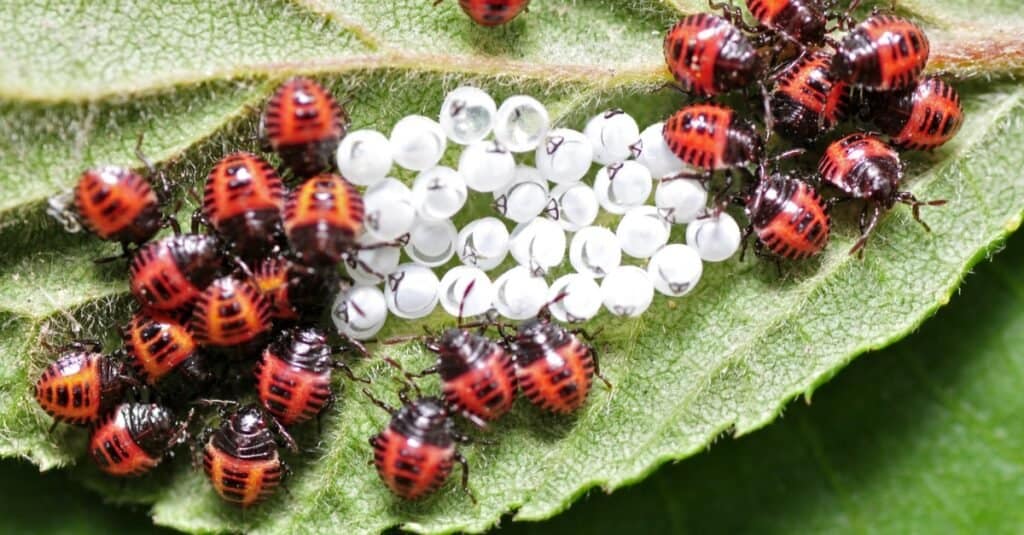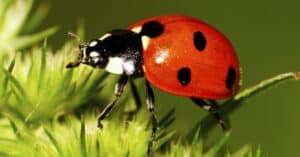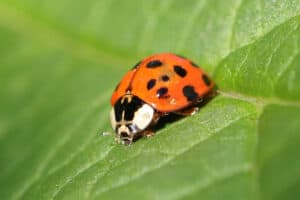Biological control using an insect’s natural enemies is one of the simplest and most effective strategies gardeners use to keep pest populations under control. The Ladybug beetle is one of the most popular beetles used to control the population of insect pests. If you have aphids in your garden, you’re probably wondering if this bug can help you keep your aphid population under control. This leads to questions like “Do ladybugs eat aphids, and are they effective against aphid infestations?”
An aphid infestation often leads to yellowing or curly leaves as they suck sap from the plant. These nasty insects also deposit a sticky fluid known as mildew on the plant, which gives rise to a sooty mold on the plant. Aphids can cause stunted growth, spoil crops, and even cause viral and bacterial infections. So are ladybugs effective against aphids?
Do Ladybugs Eat Aphids?

Ladybugs eat aphids, in fact, they are often introduced as a biological control for this prolific insect.
Yes. The common ladybug or lady beetle is a great natural enemy of aphids and is often used as a biological control for this insect. According to some estimates, an adult ladybug can easily eat up to 50 aphids in just one day. Their larvae also feed on aphids and can eat their body weight in aphids per day as well.
If you’re fortunate to have ladybugs in your garden, your chances of having an aphid infestation are reduced significantly. Although this can happen naturally, you can also help things along by introducing ladybugs to your garden on your own.
Releasing ladybugs into your garden is an effective control against aphids. How effective this will be depends on the area, the number of ladybugs you release, and how well they’re handled. Aphids are not the only insect pests that ladybugs can help you control. They’re also effective for other soft-bodied insects, and they’re unlikely to become a problem themselves, making them a great way to control pest populations.
Tips To Make Ladybugs Stay In Your Garden
Both adult ladybugs and their larvae feed on aphids and other pests. However, you have to handle the release properly to get the best results. Following the directions for releasing ladybugs makes them effective for controlling aphids. Here are a few tips to keep in mind:
Timing Is Important
You can’t introduce ladybugs as a preventive measure against aphids. You would be disappointed because ladybugs often disperse as soon as you release them, especially if they can’t find anything to feed on in your garden. If your garden is clean, they’ll leave and go elsewhere in search of food. This means you have to make sure you already have an aphid infestation before introducing ladybugs into your garden.
Release Ladybug At Dusk Or In The Early Evening
The time of the day you release them is important too. If you release ladybugs when the sun is shining bright in the afternoon, they’ll most likely disperse immediately. Releasing them in the evening when the weather is cooler will encourage them to stay longer.
Release The Bugs Close To The Plant

Release ladybugs close to plants with an active aphid infestation.
©Vera Buhl – Public Domain
Before you release ladybugs, it helps if you can identify plants with an active infestation. Then you can release the beetle close to the base of the plant or in the shadow of the low branches of the plant. The bugs will most likely crawl up the plant in search of the aphids, ensuring that they get rid of the infestation for you.
Don’t Release Ladybugs Right After Chemical Treatment
If you have just sprayed your garden with a chemical insecticide, especially one that would leave a toxic residue, you should not release the ladybugs yet. These insecticides kill pests and beneficial insects, and your ladybugs don’t stand a chance against them. Mild insecticidal soaps or horticultural oils such as neem oil will not harm your lady beetles.
You’ll Need A Sufficient Number

Large numbers of ladybugs must be released for control of an active aphid infestation.
©QiuJu Song/Shutterstock.com
Ladybugs in your garden will only control the aphid population effectively if they’re released in sufficient numbers. The problem, most of the time, isn’t because the ladybugs cannot handle the aphid population. Studies have shown that even with an active infestation, the majority of the ladybugs you release will fly away within a few days of releasing them. To compensate for this, you should release a large number of these beetles. Experts recommend releasing two batches of at least 1500 lady beetles about one week apart for a heavily infested garden. How much you’ll really need depends on the size of your garden and the severity of the infestation.
Most packages of ladybugs sold at retail outlets contain just enough beetles to treat a single infestation on a few small plants. However, you can buy more than one package for multiple releases into your garden. Ladybugs can be kept in a container and stored in a refrigerator until you’re ready to use them.
Feed Your Ladybugs
You might be able to keep your ladybugs around long enough to establish a colony in your garden in the long term. To do this, you’ll need to supply certain blossoming flowers or herbs to provide the nectar they need for reproduction. Plants like dill, mint, yarrow, and clover work for this purpose.
Where To Get Ladybugs
So now that you know ladybugs can eat aphids, where can you get them from? A lot of retail nurseries or garden centers offer lady beetles for sale. The type of beetles they sell is known as convergent lady beetles (a reference to the converging white marks on the insect’s thorax).
The beetles are collected from overwintering aggregations in the foothills and mountains of California and are the only type sold commercially. However, other wild varieties of ladybugs also feed on Aphids.
It is difficult to estimate the number of lady beetles you’ll need to release to effectively control aphid populations in a small garden. Generally, an adult ladybug can eat up to 5000 aphids in its lifetime. They eat up to 50 per day, which means they will be quite effective when released in abundant numbers.
The most important thing is not the number of these bugs you release but how effectively you managed the release. Also, multiple releases of these insects may be necessary since ladybugs often fly away after a few days.
You can also combine this control method with other cultural aphid management practices such as using topic oil sprays, insecticidal sprays or hosing off with water.
Also, note that even with a well-controlled release, ladybugs will most likely be gone within 4-5 days. They are unlikely to lay eggs on your plants or form a colony unless you take specific measures. If the aphids return a week or two after the initial release, you’ll have an aphid infestation again.
Conclusion – Do Ladybugs Eat Aphids?
So do ladybugs eat aphids? Absolutely. But are they effective against aphids? I’ll say that depends. If you release a sufficient number of ladybugs and control their release appropriately, they should be effective enough to help get rid of the infestation you’re dealing with. With multiple and well-timed releases, lady beetles can help keep aphids away from your garden.
Up Next
Are Ladybugs Poisonous or Dangerous? – Ladybugs are undoubtedly beautiful insects but are they poisonous or safe for humans? Read this to find out.
What Do Ladybugs Eat? – Ladybugs are farmers’ best friends because they feed on bugs in gardens. Read all about the diet of these highly beneficial insects.
How Long Do Ladybugs Live?– having ladybugs in your garden is often considered a sign of luck. But how long do ladybugs live?
The photo featured at the top of this post is © iStock.com/Henrik_L
Thank you for reading! Have some feedback for us? Contact the AZ Animals editorial team.






